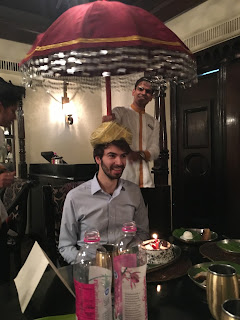Day 6:
Today was the first day of our overnight trip to the villages. We got up bright and early to drive out of Kumasi, picking up Deborah along the way. After a few brief stops along the road to pick up food and two friends of the venture, Joe and Jerry (who were along for the weekend), we made our way to our first user visit in Domeabra. While seeing our customers is always exciting, this visit was particularly so because our meetings in Domeabra were with women who purchased the first two machines produced entirely by ITTU and sold by our project manager and sales representative in Ghana, all without any input or assistance from our team in Boston. This is a critical milestone in our pilot study, and a huge learning opportunity for our team.
On the road to Domeabra
We found our first user* hard at work toasting up some freshly grated and pressed cassava to make gari. Since she has only had QueenTech (the name of our venture) machines for about three weeks, we were very curious to hear about her experience. Our business team engaged her in a productive conversation, learning all about her processing business and how the machines are changing the way she works. During this time the tech team inspected the grater and press, tweaking some parts and updating hardware to make sure that we left our customer with the most robust and current machine possible. We were also able to identify and record a few production errors, so we can make sure to address them as we work to make manufacturing and assembly easier for our partners at ITTU.
One of our users cooking gari
Next, we met with another woman in Domeabra who had recently purchased QueenTech machines. She greeted us at her door after hearing her dog growling to protect her newborns as we approached. As she signaled for us to enter, we heard Deborah send out a shout after seeing a potential sales representative hire (with whom we had spoken earlier in the week) standing in the living room. We had not heard from him earlier in the morning and it was a surprise to see him at our client’s house.
After a quick inspection and touch-up of our user’s machines, we took advantage of the fact that our potential sales representative hire was with us. We put together a quick meeting to get to know him, finding out he is a local Agricultural Extension Officer, and had a good discussion about what the potential role with QueenTech would entail. We decided to follow up later as we had a schedule to keep to and were running behind. As the venture scales and production increases, we will be looking for more sales reps with knowledge, networks, and most importantly a passion for our mission of helping grow women’s small businesses.
After finishing up our meetings, we headed over to our lodgings for the night in Pekyerekye. The tech team set up shop in a courtyard, racing the sun to complete the assembly of our prototype machine. After putting on the finishing touches, we had time to grate some cassava to make sure it was performing up to our standards.
The freshly assembled grater, ready for testing
While the tech team stayed at the lodgings to work on the machine, the business team headed out to have a meeting with the chief of the village and meet more of our users. We met with the chief of the village to let him know of our presence and purpose for being there, bringing him a gift to show our gratitude.
Offering our gift at the chief's meeting
As soon as the meeting ended we were taken to the homes of two of our users, and learned a great deal from the wear the machines have incurred, while getting to meet their entire families.
We regrouped at our lodgings, where we enjoyed a home-cooked meal and set up our mosquito nets, then settled down for bed ahead of another full day.
*Because the villages we work in are so small, we avoid using our operator’s names to preserve their privacy.
Day 7:
Getting up early to pack up and move out, we started our second day in the villages. Our first visit, also in Pekyerekye, was to one of our long-time customers who is also our first sales rep. She has owned a grater and press for a year, and has been helping us test a prototype grater at the same time. The tech team updated and tuned her machines while she and the business team engaged in co-design around our new sales rep contract, which will be critical as we move forward and expand our sales network.
Discussing terms of the sales rep contract
We were also, for the first time, able to leave a brand new grater and press with our representative. This means that she has inventory on hand to sell as soon as she finds an interested and qualified buyer, instead of having to delay a sale to wait for machines to be produced.
Peeling cassava for the grater
Having learned so much in just two short days and having seen the impact of our venture, we can't wait to get back to the shop at ITTU tomorrow. We'll get to work helping our manufacturing partners create machines faster and more efficiently so we can get more graters and presses in the hands of the women who want them.












